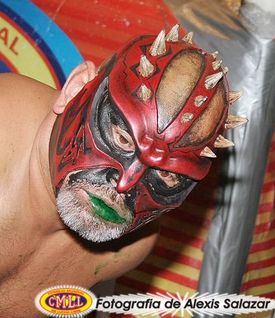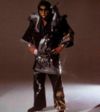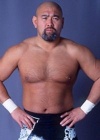The Great Muta: Difference between revisions
Rzombie1988 (talk | contribs) |
Rzombie1988 (talk | contribs) No edit summary |
||
| Line 83: | Line 83: | ||
|caption= Mutoh with Hair | |caption= Mutoh with Hair | ||
}} | }} | ||
== Source == | |||
- http://en.wikipedia.org/wiki/Keiji_Mutoh | |||
- http://www.greatmuta.net | |||
- http://www.geocities.com/jpuroresu | |||
Revision as of 19:18, 16 August 2006
Profile
| Wrestling Observer Hall Of Fame Member |
|---|
Biography
Mutoh was trained to be a professional wrestler by Hiro Matsuda in the New Japan Pro Wrestling Academy. He debuted on October 5, 1984 against Masahiro Chono. Mutoh's initial NJPW run was largely uneventful, the only noteworthy event being a six day IWGP World Tag Team Championship reign with Shiro Koshinaka. In the mid-1980's, like most Young Lions, Mutoh was sent on a learning excursion to North America for seasoning. After runs in Puerto Rico and Florida, Mutoh's "Great Muta" personality and ring skills earned him a high billing in the National Wrestling Alliance. During this period, Muta would feud with stars like, Lex Luger, Ric Flair, and especially Sting, eventually capturing the NWA World Television Championship in 1989 in a match with Sting. He eventually lost the championship to Arn Anderson, and returned to action in Japan part-time in 1990, going between his real name and his Muta gimmick as he pleased.
Mutoh quickly rose in rank in 1990, establishing his long-time friendship and rivalry with Chono and winning his second IWGP Tag Team title alongside him. He eventually lost it to another long-time rival in his Great Muta gimmick, Hiroshi Hase, and his partner Kensuke Sasaki.
In 1991, Mutoh and Chono, along with Shinya Hashimoto, cemented their status as the next generation of New Japan, after the finals of the first G-1 Climax tournament. In a 30 minute match, Mutoh was bested by Chono, and together with Hashimoto, the three celebrated in the ring, and afterwards they were labelled the Three Musketeers of New Japan Pro Wrestling. 1992 saw Chono repeat his success in the G-1 Climax (winning the NWA World Heavyweight Championship in the process); just four days later, Mutoh -- donning his Muta persona -- beat Japanese legend Riki Choshu for the IWGP World Heavyweight Championship, his first reign. At the end of the year, Muta faced Hiroshi Hase in a famous match where Hase used a foreign object to beat at Muta's forehead, payback for their previous encounters. Muta bladed and cut very deeply into his forehead. As a result of this, Muta bled profusely for the rest of the match, and to this day he still bears scars from where he sliced. As a result of this match, many fans of professional wrestling compare other bladejobs to Muta's on a "Muta Scale."
For a short time in 1993, after beating Chono in a title vs. title match, Muta held both the NWA and IWGP championships; the unification was short-lived, as Barry Windham beat him a month later. As IWGP champion, Muta had a variety of challengers in title matches and exhibitions, including Hulk Hogan, Sting, and his fellow members of the Three Musketeers, Chono and Hashimoto, before finally losing the title on September 20, 1993 to Hashimoto.
Following this title loss and a match with Hogan against the Hellraisers -- the team of Hawk Warrior and Kensuke Sasaki as Power Warrior -- Mutoh returned to fighting primarily under his real name, reviving the Muta name for certain matches, such as a special match with Antonio Inoki during his retirement countdown. During this time, Mutoh created a team with Hiroshi Hase, working their way up the ranks against the likes of the Steiner Brothers to challenge Hawk Warrior and Power Warrior and capturing the IWGP Tag Team championship -- his third tag title.
While having the Tag Team title around his waist was fine, Mutoh had further ambitions: beating the man who took his title, Shinya Hashimoto -- by now the IWGP champion for nearly a year. Vacating his tag team championship to focus on his quest, his second title reign came on May 3, 1995 -- a year and two days after Hashimoto won the championship. Mutoh held the title throughout the rest of the year, leading New Japan in the opening battles of the feud with Nobuhiko Takada and the UWF-i army before losing his title to Takada on January 4, 1996.
The latter half of 1996 had Mutoh pitted against Chono's Ookami Gundan -- or Wolf Army -- which eventually blossomed into a war with the Chono-led nWo Japan. In the process, Mutoh began teasing at a possible turn to the side of the nWo, proclaiming himself to be the true successor to Antonio Inoki's legacy, and "accidentally" attacking his own partners in the middle of a match. During this period, Mutoh underwent a long slump in big matches -- losing not only to members of the nWo, but fellow New Japan wrestlers such as Hashimoto; and many times the turn was teased -- Mutoh even going so far as to wear an nWo shirt and then proclaim days later that he refuses to join Chono's army. Mutoh further raised confusion by playing both sides of the feud -- fighting as a member of New Japan under his real name, and using the Great Muta name as a member of nWo Japan, before turning to his Muta gimmick full-time for several months in 1997.
The full turn came in September of 1997, when Mutoh, after teasing a turn on his nWo teammates, double-crossed Sasaki and Kazuo Yamazaki, sealing away the Muta name and formally joining nWo Japan as himself. Almost immediately following this, he and Chono dominated the tag team scene in NJPW, defeating Yamazaki and Sasaki for their second IWGP tag title reign as a duo, and spraypainting the plates of the belts black as a show of disrespect for the championship's legacy.
They would eventually be forced to vacate the title in 1998, when Mutoh injured his knees, his years of using the moonsault press finally catching up to him. During this time, he took a hiatus from action, returning just before the 1998 G-1 Climax (from which he was eliminated by Genichiro Tenryu). Despite his return, however, Mutoh was plagued by this nagging injury, fighting through his pains throughout the rest of 1998 and much of 1999 -- even winning his third IWGP title from one of Chono's right-hand men, Scott Norton.
This event set the tone for Mutoh's year, as he feuded with Chono for the name of the new World order -- which evolved into a war between the nWo, led by Mutoh, Hiroyoshi Tenzan, and Satoshi Kojima... and Chono's new Team 2000 unit, with himself, Don Frye, nWo Sting, and others from the old generation of the nWo. The war was lost by Mutoh by the beginning of 2000, brought about by his decisive loss to Chono on January 4. Mutoh took an extended hiatus to rehabilitate his damaged knees after that, focusing instead on one last run in America for World Championship Wrestling alongside Vampiro. However, due to bad booking and the decline of the WCW in its last years, Mutoh could not recapture the previous popularity he had in the early 1990's.
Going back on hiatus, it seemed as if Mutoh reached a confusing crossroads in his career; however, he chose to completely change his image, shaving his head bald (he had a pronounced receding hairline throughout much of 2000) and aligning himself with a fellow NJPW wrestler who had gone overseas for an extended period of time, Shinjiro Ohtani. The two returned to New Japan on January 4, 2001, making short work of Manabu Nakanishi and Jyushin Thunder Lyger. In his first singles match after returning to New Japan, Mutoh also debuted his new trademark move, the Shining Wizard. Since its creation, it has become an extremely popular move on both sides of the Pacific, used by Mutoh's allies, rivals, and fans of his work.
Together with Don Frye, Ohtani and Mutoh created a new stable which later came to be known as BATT -- Bad Ass Translate Trading. Added to their ranks were Taiyo Kea of All Japan Pro Wrestling, and Jinsei Shinzaki of Michinoku Pro; and later Hiroshi Hase, now a member of All Japan with Kea.
2001 proved to be Mutoh's year of renewal besides the formation of a new unit, as he challenged -- and defeated -- Tenryu for All Japan's coveted Triple Crown. In addition, Mutoh captured more gold in the form of All Japan's Double Cup tag titles and IWGP World Tag Team Championship in the summer and fall of 2001, both with Taiyo Kea -- giving Mutoh a total of six belts at one time.
In 2002, Mutoh shocked the Japanese wrestling world by making his home in All Japan, with Satoshi Kojima and Kendo Kashin following him, and Kaz Hayashi joining from America; In September of the same year, in gratitude for his support, All Japan president Motoko Baba (widow of founder Giant Baba) transferred all of her stock to Mutoh, making him the president of the company. Despite this position, however, Mutoh has not stopped wrestling full-time for All Japan, and leads his supporters in feuds with RO&D and the Voodoo Murderers alike.
In 2004, he played the role of Harold Sakata in the movie Rikidozan, a film based on the real-life story of a wrestler who would eventually be known as the "Father of Puroresu." Harold Sakata was the man who took Rikidozan under his wing and introduced him into the world of professional wrestling.
Regardless of his allegiences and gimmicks, Keiji Mutoh has endured as one of Japan's top stars, and one of the most recognizable Japanese wrestlers worldwide.
Alter Egos
Great Muta, which he has wrestled as fairly continuously throughout his career, switching back and forth between this character and his real name. Great Muta is a mysterious gimmick where he spits green or red mist and plays mind games to distract his opponents. Muta was originally billed as the son of Japanese wrestler Great Kabuki who used a similar gimmick. The two are not related in real life. Originally he wore face paint, which was later exchanged for a mask after he shaved his head. The Great Muta gimmick is the gimmick most fans of the United States know Mutoh for, as he wrestled as The Great Muta throughout the late '80s and early '90s for the NWA with it.
Kokushi-Muso, a gimmick used only for a few shows. It is a play off of Jinsei Shinzaki's monk character known as Hakushi. Hakushi means "White Angel" while "Kokushi" means "Black Angel".
White Ninja, was used early in his career in New Japan Pro Wrestling and in Florida Championship Wrestling.
Super Ninja, was used in the World Wrestling Council in Puerto Rico.
Super Black Ninja, was used in World Class Championship Wrestling in Texas.
Gallery
Source
- http://en.wikipedia.org/wiki/Keiji_Mutoh - http://www.greatmuta.net - http://www.geocities.com/jpuroresu



